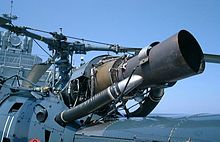Turbomeca Artouste
Appearance
| Artouste | |
|---|---|

| |
| Turbomeca Artouste IIIB | |
| Type | Turboshaft |
| National origin | France |
| Manufacturer | Turbomeca |
| Major applications | Aérospatiale Alouette II Aérospatiale Alouette III |
| Developed into | Continental T51 |
The Turbomeca Artouste was an early French turboshaft engine, first run in 1947. Originally conceived as an auxiliary power unit (APU), it was soon adapted to aircraft propulsion, and found a niche as a powerplant for turboshaft-driven helicopters in the 1950s. Artoustes were licence-built by Bristol Siddeley (formerly Blackburn) in the UK, Hindustan Aeronautics Limited in India, and developed by Continental CAE in the USA as the T51. Power is typically in the 300 kW (400 hp) range.
Applications
- Aérospatiale Alouette II
- Aérospatiale Alouette III
- Aerospatiale Lama
- Aerotécnica AC-14
- Handley Page Victor - as APU
- Hawker Siddeley Trident - as APU
- SNCASO Farfadet
Engines on display
A Turbomeca Artouste is on public display at:
Specifications (Artouste IIIB)

Data from FAA TCDS[1]
General characteristics
- Type: Turboshaft
- Length: 71.4 in
- Diameter: 26.25 in
- Dry weight: 393 lb
Components
- Compressor: Single stage centrifugal plus single stage axial
- Combustors: Annular combustion chamber
- Turbine: Three stage turbine
Performance
- Maximum power output: 858 shp at 33,500 rpm
- Turbine inlet temperature: 550 C
See also
Related development
Related lists
References
Wikimedia Commons has media related to Turbomeca Artouste.
- ^ FAA Type Certificate Data Sheet Retrieved: 2 November 2008
- Gunston, Bill (1986). World Encyclopedia of Aero Engines. Wellingborough: Patrick Stephens. p. 163.
{{cite book}}: Cite has empty unknown parameter:|1=(help) - Turbomeca website
| This aircraft engine article is missing some (or all) of its specifications. If you have a source, you can help Wikipedia by adding them. |
